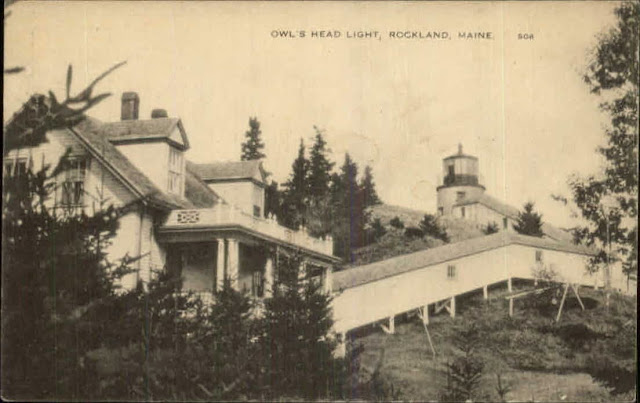Architectural styles of lighthouses vary greatly, as do their geographic locations. In colder regions many lighthouses were designed with covered walkways between buildings. These facilitated lightkeeping--lightkeepers could access the light tower from their house without ever going outside--and reduced the work of shoveling snow and keeping a trail to the light tower cleared.
Above is Owls Head Lighthouse in Maine. In 1903 a 60-foot covered way was built between the lighthouse and the oilhouse. Three years later another walkway connected to the first and provided a weather-free link between the keeper's quarters, the light tower, and the oilhouse. The keeper, if he so desired, could tend the lighthouse in pajamas, though I doubt any ever did. The covered way simply made access easier and safer. The keeper still had to trek outside to work the fogbell. Owls Head's covered way is gone today.
Safety was a great concern at some lighthouses. At White Island Lighthouse in the Isles of Shoals, New Hampshire, situated on an island several miles off Portsmouth, the covered way (seen in the old postcard and HABs b&w view below) protected the keepers from the sea. Waves could breach parts of the island during severe storms. The walkway itself was damaged on several occasions by storm waves. The keepers reported how fearsome the sound of the waves was at they crashed over the walkway.
While most covered ways were found in New England, smaller ones were seen in other parts of the nation, such as the Great Lakes lighthouses.
Terry Pepper of the Great Lakes Lightkeepers Association took this picture of the covered way at St. Helena Lighthouse, Michigan.
Here are some other examples of covered ways at lighthouses--
Block Island Southeast Lighthouse in Rhode Island had the light tower connected directly to the house. (Coast Guard Archives supplied the b&w images in this section and the next)
Of course, if you lived in this lighthouse below, at Barbers Point, Hawai'i, there was no need for a covered way. In fact, a jaunt from the quarters to the light tower was pleasant and clement!!
|












No comments:
Post a Comment
I welcome your comments, photos, stories, etc.!